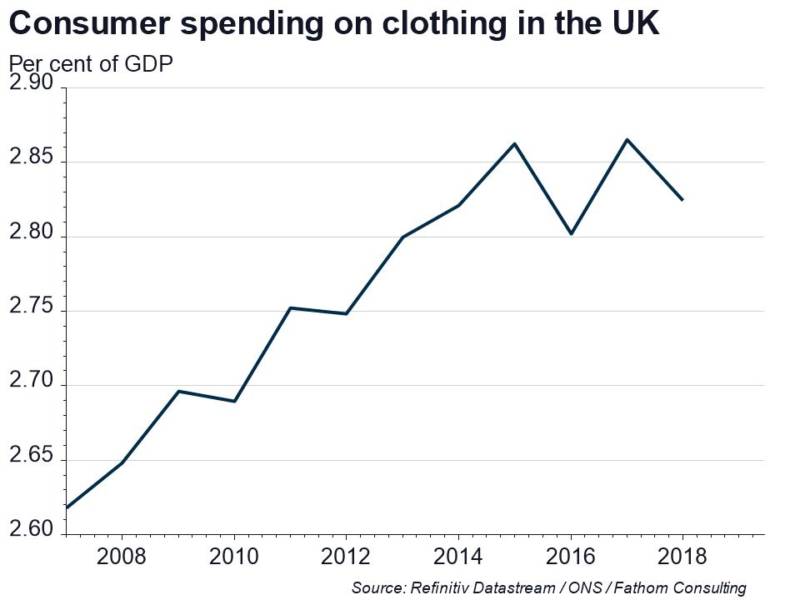A sideways look at economics
Over the years annual expenditure on clothing in the UK has steadily increased as a share of GDP. People are topping up their wardrobes with the latest fashion, from the ridiculously overpriced Yeezy trainers pioneered by Kanye West (which seem to me to be classifiable as ‘fashion’ only in a very loose sense of the word), to the less expensive side of the spectrum from the likes of ASOS or Boohoo. Is this an efficient form of expenditure? This TFiF looks into how much of that full-to-the-brim wardrobe the average consumer, and Fathomite, actually wears, and whether there is a way to reuse that dreadful knitted jumper that Auntie Jean gave as a gift last Christmas.
One of the biggest trends over the last decade is the growth of online retailers. This is creating a difficult environment for high street stores, such as Primark, who struggle to compete as their price point can’t support the cost of physical stores and home delivery. Worldwide, clothing is the most popular online shopping category, with 57% of global internet users having bought clothing products online in 2018. The ease of online shopping, combined with the growth in popularity of low-cost online retailers, such as Boohoo, who saw revenue growth of 47% within the 2018/19 financial year, is creating an environment that is encouraging of a ballooning wardrobe.

Online shopping really is just like magic: with just the click of a button a new outfit can arrive at your house the next day. Have a Christmas party coming up? Why not order ten dresses and see which one you like best? Can’t decide between two dresses? Well you didn’t spend too much money on them, so why not keep both – ‘just in case’. Many of us have followed this thought process and justification for purchasing clothes we don’t really need, especially as you could re-wear last year’s dress seeing as very few people will remember it. (But you’re not thinking rationally – you’re worrying about the Insta.) Consequently, it’s really no surprise that studies have found that a whopping 23% of Londoners’ clothes are unworn. It’s not clear whether this is made up of Auntie Jean’s Christmas gifts, the ‘just in case’ dresses, or that pair of jeans that someday you WILL fit in (but realistically, are more likely to split before they ever get past your thighs). Whatever the composition, the purchase, and subsequent neglect, of these items doesn’t always provide a marginal benefit. In terms of the jeans, they could even provide a disutility, with the pain of not being able to squeeze them on leaving you feeling dismayed.
The wonders of online shopping are contributing to an average Londoner spending £49 per month on footwear and clothing, or £590 a year. Comparing this to a poll of the office, the average Fathomite spends £64 per month, or £768 a year. If much of the wardrobe is only worn a handful of times (at Fathom, 22% of our wardrobes have not been worn in over a year) – or never (8%), is this efficient expenditure? Based on the Fathom average, the money could be better spent on 153 pints of beer a year at our local drinking establishment, which for some (/all Fathomites) would perhaps provide a much greater marginal utility (at the time of course, maybe less so the next morning). Alternatively, the money could be put towards something boring, like rent. Whatever the money is spent on, the message remains the same, why are we spending on clothes, when a large proportion goes unworn?
The buzz word floating around at the moment is fast fashion. This is the idea that the average consumer can buy the latest trend, very soon after it has hit the catwalk, at a relatively affordable price. However, these trends can quickly become unfashionable, resulting in people often rushing to get the next ‘hot look’, sometimes leaving last season’s clothes unworn. This is highlighted in the chart, which shows that since 2002 the average number of times a new garment is worn has fallen by 35%. Fast fashion definitely gets a bad rep, and quite rightly so. It has a huge effect on our environment, which we will touch on in future research as part of our exploration of climate-related issues. It has also been associated with bad labour practices. However, it’s important to note that there are economic benefits in terms of encouraging consumer spending, a vital component of GDP.

So, you want to keep up with the latest style flaunted by the Kardashians, support the economy by spending those hard-earned pennies, but reduce the waste that comes with this? Well the answer is simple – upcycling! This is the idea that instead of throwing away unused clothing, you can reuse it to create a new product. I came across this idea when graduating from university and seeing my family’s horror at the extensive collection of ‘Team Surrey’ sports tops I had hoarded over the years (yes…I was one of those). I couldn’t bear to chuck them, but I also couldn’t justify keeping them. As a consequence, I decided to upcycle them, and transform them into a blanket (see below). As I’m about as creative as a rock, I paid someone else to do this (further supporting the economy, what a good economist I am).
This links into an initiative called the circular economy, in which we develop technology to transition to a world where nothing is wasted. It has many environmental benefits, but is predicted to help the economy, too. Making circular use of materials can make a more resilient, productive economy. By reusing materials, we can cut costs, reduce our dependence on materials and energy and become more competitive. The European Union have already made efforts to begin this transition, with an action plan in place, which aims to maintain the value of products by returning them to the product cycle at the end of use. However, the question remains whether fast fashion can survive this transition, considering typical items are not designed to be long-lasting and therefore have less potential to be reused. As more countries develop schemes to promote a circular economy, we expect it to gain global traction in the coming years.
A fully circular economy is a long way off, but it is part of our future. For now, if you can’t bear to part ways with your treasured possessions, you can always buy a bigger wardrobe…
